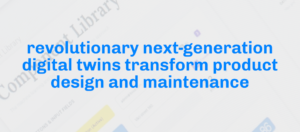::: nBlog :::
Our this year’s streak at Hannover Messe clearly showed that the industry is preparing for Digital Twins, AI and Big Data. The terminology is still vague and many times industrial automation or M2M SIM cards are just rebranded as Industrial Internet, but the momentum is good.
Now Digital Twins have been around since the 1960s when NASA was creating the both physical and digital replicas from their huge-budget spacecraft. From there it spread to CAD/CAM industry, quite naturally, as more and more high resolution displays and powerful design workstations were introduced.
In most contemporary literature, a Digital Twin is a continuously data-fed computer simulation of a large industrial piece of equipment, such as a bottling machine. It helps the machine operator and owner to plan predictive maintenance and gradually improve the machine efficiency. The machine manufacturer also gets a data feed, which helps in R&D efforts. Nice closed loop architecture, but slow and rigid.
Now BaseN sees that such a twin is merely a cousin, as the physical machine still plays the primary commercial and technical role. A real Digital Twin is a master object, containing all programming and information in order to build and operate its physical counterpart. And when AI and similar adaptive algorithms are added, we’re looking at a Spime.
BaseN also postulates that the real Digital Twin and Spime revolution will ensue when the end products and also taken into the equation, with a possibility that the distribution chain is radically changed. So there must be a spime not only for the bottling machine, but for each bottle and its contents, including data from the supply chain to the consumer, and the consumer satisfaction level, per bottle. The manufacturer might end up having millions of ..direct customers.
Now, when powerful CAM/CAM companies such as Autodesk, Dassault Systemes and PTC are trying to push their Digital Twin world view to their industrial customers, so are the ERP behemoths like SAP, Oracle and lately Salesforce who occupy the Supply Chain and Customer Relationship Management space. The challenge is, though, that these world views are often not compatible and are poised to maintain their legacy dominance.
The final spime frontier is the decomposition of the first industrial revolution, which rid us the value of true customer adaptation in favor of cheap mass production, which in turn left massive scars to our planet of limited resources. Although the Adam Smith legacy still lives strong in some industry leaders’ minds, we are finally closing the loop all the way to the end user.
//Pasi



